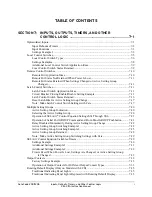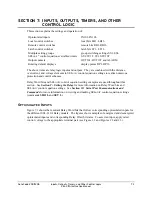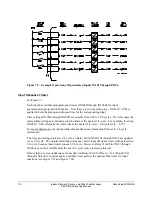
Date Code 20011205
Inputs, Outputs, Timers, and Other Control Logic
7-11
SEL-311A Instruction Manual
Remote Bit States Not Retained When Power Is Lost
The states of the remote bits (Relay Word bits RB1 through RB16) are not retained if power to
the relay is lost and then restored. The remote control switches always come back in the OFF
position (corresponding remote bit is deasserted to logical 0) when power is restored to the relay.
Remote Bit States Retained When Settings Changed or Active Setting Group Changed
The state of each remote bit (Relay Word bits RB1 through RB16) is retained if relay settings are
changed (for the active setting group or one of the other setting groups) or the active setting
group is changed. If a remote control switch is in the ON position (corresponding remote bit is
asserted to logical 1) before a setting change or an active setting group change, it comes back in
the ON position (corresponding remote bit is still asserted to logical 1) after the change. If a
remote control switch is in the OFF position (corresponding remote bit is deasserted to logical 0)
before a settings change or an active setting group change, it comes back in the OFF position
(corresponding remote bit is still deasserted to logical 0) after the change.
If settings are changed for a setting group other than the active setting group, there is no
interruption of the remote bits (the relay is not momentarily disabled).
L
ATCH
C
ONTROL
S
WITCHES
The latch control switches are enabled using the ELAT setting. Set ELAT to the number of latch
control switches that are desired (N, 1–16).
The latch control switch feature of this relay replaces latching relays. Traditional latching relays
maintain their output contact state when set. The SEL-311A latch bit retains memory even when
control power is lost. If the latch bit is set to a programmable output contact and control power
is lost, the state of the latch bit is stored in nonvolatile memory but the output contact will go to
its deenergized state. When the control power is applied back to the relay, the programmed
output contact will go back to the state of the latch bit.
The state of a traditional latching relay output contact is changed by pulsing the latching relay
inputs (see Figure 7.10). Pulse the set input to close (“set”) the latching relay output contact.
Pulse the reset input to open (“reset”) the latching relay output contact. Often the external
contacts wired to the latching relay inputs are from remote control equipment (e.g., SCADA,
RTU).
Summary of Contents for SEL-311A
Page 6: ......
Page 8: ......
Page 10: ......
Page 24: ......
Page 40: ......
Page 66: ......
Page 96: ......
Page 98: ......
Page 112: ......
Page 114: ......
Page 122: ......
Page 170: ......
Page 202: ......
Page 204: ......
Page 246: ......
Page 248: ......
Page 286: ......
Page 290: ......
Page 304: ......
Page 306: ......
Page 334: ......
Page 384: ......
Page 386: ......
Page 394: ......
Page 398: ......
Page 402: ......
Page 404: ......
Page 410: ......
Page 412: ......
Page 426: ......
Page 444: ......
Page 460: ......
Page 474: ......















































